Analysis of Al Baik's Supply Chain Management and Cost Optimization
VerifiedAdded on 2023/06/05
|7
|1530
|428
Report
AI Summary
This report provides an in-depth analysis of Al Baik's supply chain management practices, focusing on strategies for cost reduction and operational efficiency. It begins with an overview of Al Baik, a prominent fast-food chain in Saudi Arabia, and then delves into its supply chain, highlighting the importance of cost control. The report explores various methods for reducing freight costs, including time-definite sea shipping, air-sea shipping, strategic warehouse selection, distribution center bypass, and optimizing truckload utilization. It also covers techniques such as trailer cube utilization, product class changes, and control of inbound transportation to further minimize expenses. The report recommends a five-day shipping method for replacement parts to save costs and emphasizes the importance of optimizing freight and logistics for operational efficiency. Overall, the report offers a comprehensive view of Al Baik's supply chain, providing valuable insights into cost-saving strategies and supply chain optimization.
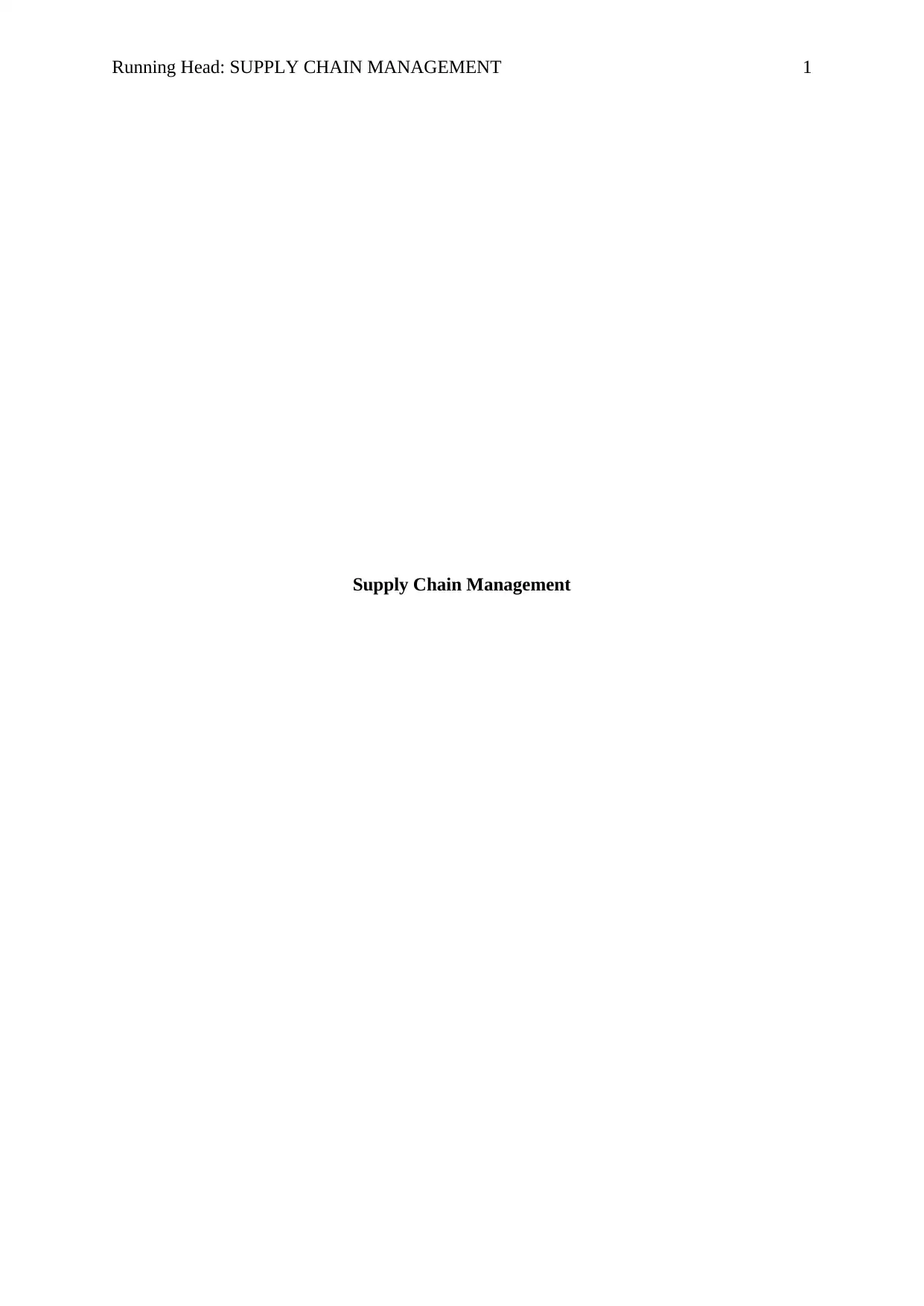
Running Head: SUPPLY CHAIN MANAGEMENT 1
Supply Chain Management
Supply Chain Management
Paraphrase This Document
Need a fresh take? Get an instant paraphrase of this document with our AI Paraphraser
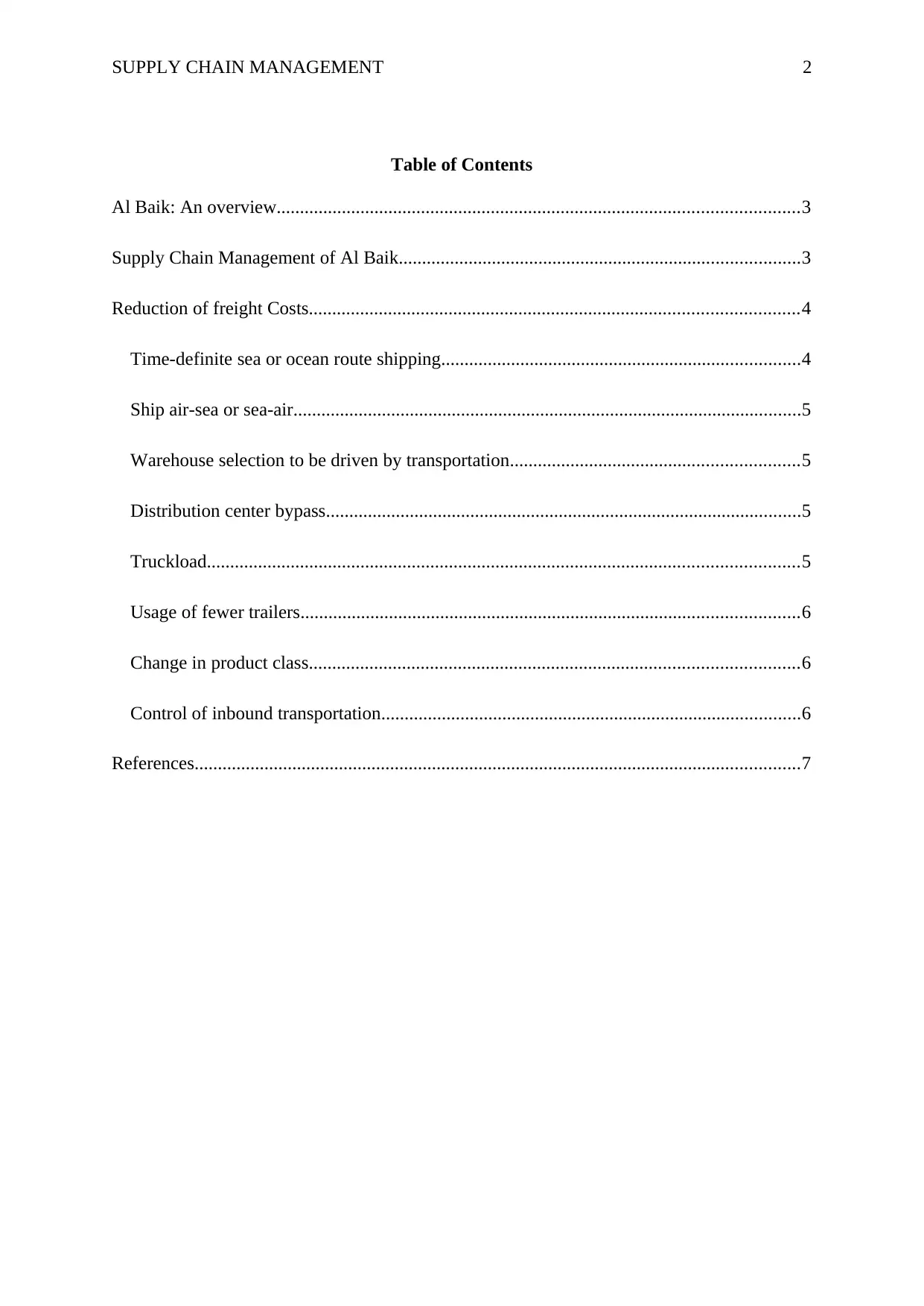
SUPPLY CHAIN MANAGEMENT 2
Table of Contents
Al Baik: An overview................................................................................................................3
Supply Chain Management of Al Baik......................................................................................3
Reduction of freight Costs.........................................................................................................4
Time-definite sea or ocean route shipping.............................................................................4
Ship air-sea or sea-air.............................................................................................................5
Warehouse selection to be driven by transportation..............................................................5
Distribution center bypass......................................................................................................5
Truckload...............................................................................................................................5
Usage of fewer trailers...........................................................................................................6
Change in product class.........................................................................................................6
Control of inbound transportation..........................................................................................6
References..................................................................................................................................7
Table of Contents
Al Baik: An overview................................................................................................................3
Supply Chain Management of Al Baik......................................................................................3
Reduction of freight Costs.........................................................................................................4
Time-definite sea or ocean route shipping.............................................................................4
Ship air-sea or sea-air.............................................................................................................5
Warehouse selection to be driven by transportation..............................................................5
Distribution center bypass......................................................................................................5
Truckload...............................................................................................................................5
Usage of fewer trailers...........................................................................................................6
Change in product class.........................................................................................................6
Control of inbound transportation..........................................................................................6
References..................................................................................................................................7
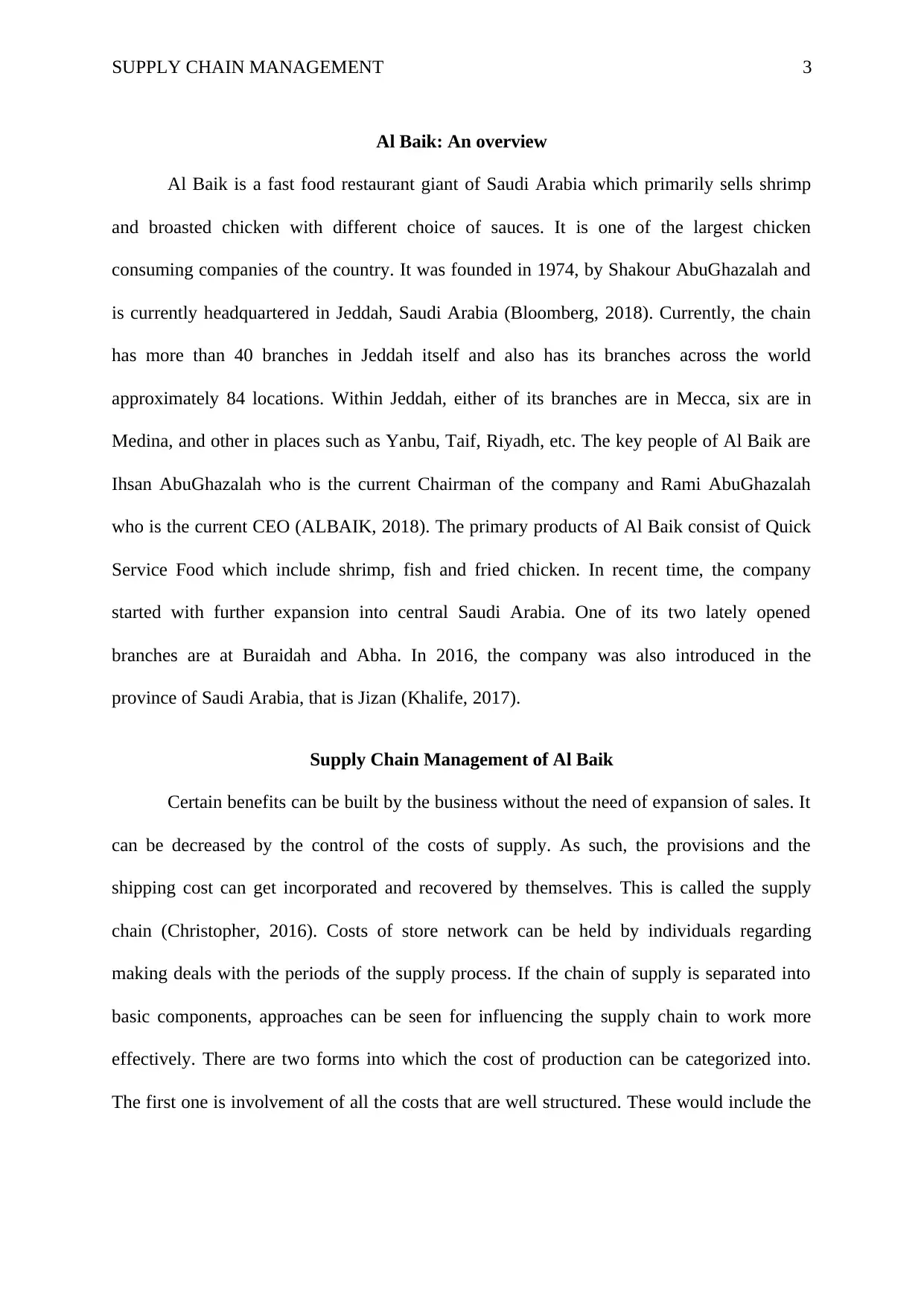
SUPPLY CHAIN MANAGEMENT 3
Al Baik: An overview
Al Baik is a fast food restaurant giant of Saudi Arabia which primarily sells shrimp
and broasted chicken with different choice of sauces. It is one of the largest chicken
consuming companies of the country. It was founded in 1974, by Shakour AbuGhazalah and
is currently headquartered in Jeddah, Saudi Arabia (Bloomberg, 2018). Currently, the chain
has more than 40 branches in Jeddah itself and also has its branches across the world
approximately 84 locations. Within Jeddah, either of its branches are in Mecca, six are in
Medina, and other in places such as Yanbu, Taif, Riyadh, etc. The key people of Al Baik are
Ihsan AbuGhazalah who is the current Chairman of the company and Rami AbuGhazalah
who is the current CEO (ALBAIK, 2018). The primary products of Al Baik consist of Quick
Service Food which include shrimp, fish and fried chicken. In recent time, the company
started with further expansion into central Saudi Arabia. One of its two lately opened
branches are at Buraidah and Abha. In 2016, the company was also introduced in the
province of Saudi Arabia, that is Jizan (Khalife, 2017).
Supply Chain Management of Al Baik
Certain benefits can be built by the business without the need of expansion of sales. It
can be decreased by the control of the costs of supply. As such, the provisions and the
shipping cost can get incorporated and recovered by themselves. This is called the supply
chain (Christopher, 2016). Costs of store network can be held by individuals regarding
making deals with the periods of the supply process. If the chain of supply is separated into
basic components, approaches can be seen for influencing the supply chain to work more
effectively. There are two forms into which the cost of production can be categorized into.
The first one is involvement of all the costs that are well structured. These would include the
Al Baik: An overview
Al Baik is a fast food restaurant giant of Saudi Arabia which primarily sells shrimp
and broasted chicken with different choice of sauces. It is one of the largest chicken
consuming companies of the country. It was founded in 1974, by Shakour AbuGhazalah and
is currently headquartered in Jeddah, Saudi Arabia (Bloomberg, 2018). Currently, the chain
has more than 40 branches in Jeddah itself and also has its branches across the world
approximately 84 locations. Within Jeddah, either of its branches are in Mecca, six are in
Medina, and other in places such as Yanbu, Taif, Riyadh, etc. The key people of Al Baik are
Ihsan AbuGhazalah who is the current Chairman of the company and Rami AbuGhazalah
who is the current CEO (ALBAIK, 2018). The primary products of Al Baik consist of Quick
Service Food which include shrimp, fish and fried chicken. In recent time, the company
started with further expansion into central Saudi Arabia. One of its two lately opened
branches are at Buraidah and Abha. In 2016, the company was also introduced in the
province of Saudi Arabia, that is Jizan (Khalife, 2017).
Supply Chain Management of Al Baik
Certain benefits can be built by the business without the need of expansion of sales. It
can be decreased by the control of the costs of supply. As such, the provisions and the
shipping cost can get incorporated and recovered by themselves. This is called the supply
chain (Christopher, 2016). Costs of store network can be held by individuals regarding
making deals with the periods of the supply process. If the chain of supply is separated into
basic components, approaches can be seen for influencing the supply chain to work more
effectively. There are two forms into which the cost of production can be categorized into.
The first one is involvement of all the costs that are well structured. These would include the
⊘ This is a preview!⊘
Do you want full access?
Subscribe today to unlock all pages.

Trusted by 1+ million students worldwide
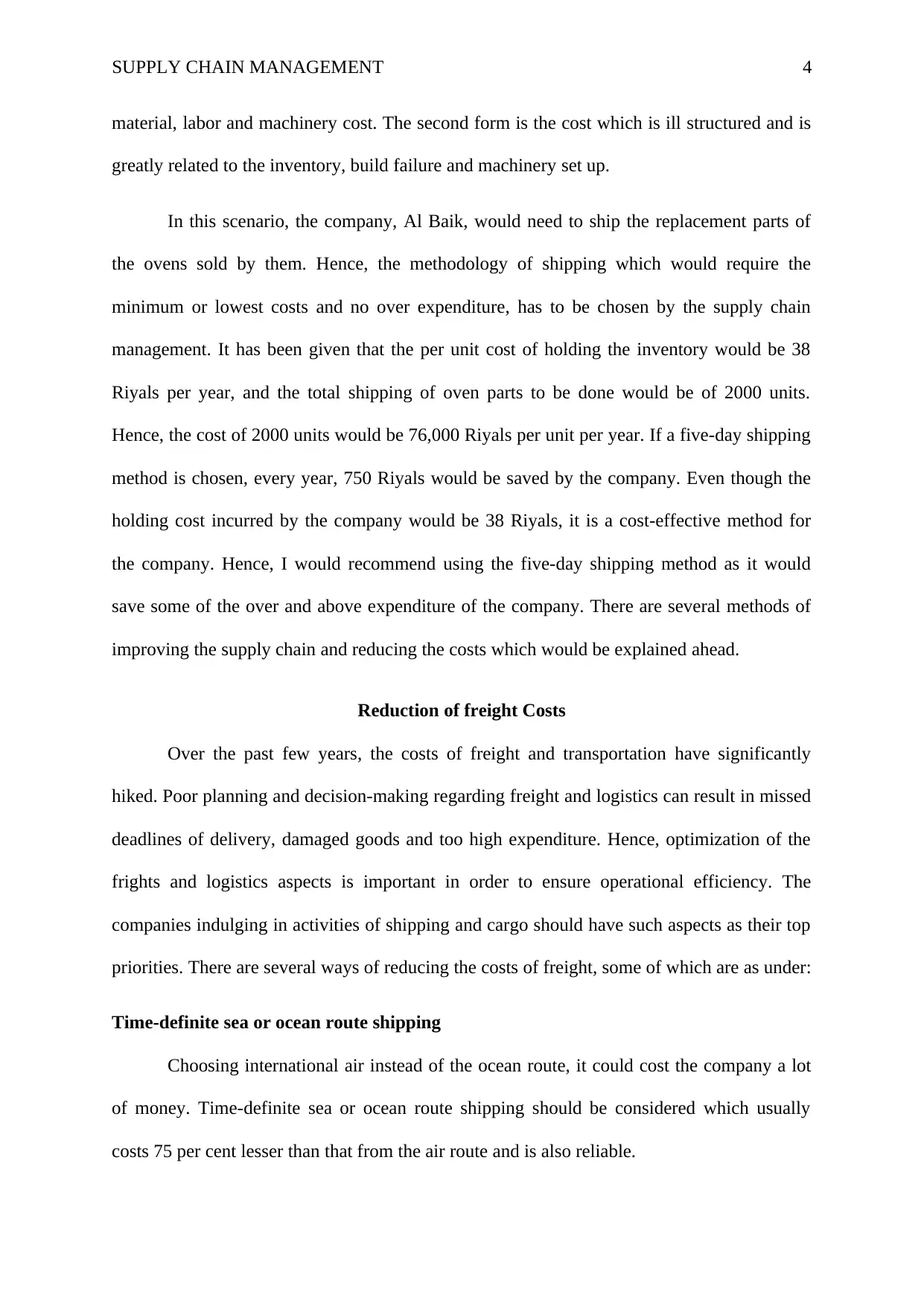
SUPPLY CHAIN MANAGEMENT 4
material, labor and machinery cost. The second form is the cost which is ill structured and is
greatly related to the inventory, build failure and machinery set up.
In this scenario, the company, Al Baik, would need to ship the replacement parts of
the ovens sold by them. Hence, the methodology of shipping which would require the
minimum or lowest costs and no over expenditure, has to be chosen by the supply chain
management. It has been given that the per unit cost of holding the inventory would be 38
Riyals per year, and the total shipping of oven parts to be done would be of 2000 units.
Hence, the cost of 2000 units would be 76,000 Riyals per unit per year. If a five-day shipping
method is chosen, every year, 750 Riyals would be saved by the company. Even though the
holding cost incurred by the company would be 38 Riyals, it is a cost-effective method for
the company. Hence, I would recommend using the five-day shipping method as it would
save some of the over and above expenditure of the company. There are several methods of
improving the supply chain and reducing the costs which would be explained ahead.
Reduction of freight Costs
Over the past few years, the costs of freight and transportation have significantly
hiked. Poor planning and decision-making regarding freight and logistics can result in missed
deadlines of delivery, damaged goods and too high expenditure. Hence, optimization of the
frights and logistics aspects is important in order to ensure operational efficiency. The
companies indulging in activities of shipping and cargo should have such aspects as their top
priorities. There are several ways of reducing the costs of freight, some of which are as under:
Time-definite sea or ocean route shipping
Choosing international air instead of the ocean route, it could cost the company a lot
of money. Time-definite sea or ocean route shipping should be considered which usually
costs 75 per cent lesser than that from the air route and is also reliable.
material, labor and machinery cost. The second form is the cost which is ill structured and is
greatly related to the inventory, build failure and machinery set up.
In this scenario, the company, Al Baik, would need to ship the replacement parts of
the ovens sold by them. Hence, the methodology of shipping which would require the
minimum or lowest costs and no over expenditure, has to be chosen by the supply chain
management. It has been given that the per unit cost of holding the inventory would be 38
Riyals per year, and the total shipping of oven parts to be done would be of 2000 units.
Hence, the cost of 2000 units would be 76,000 Riyals per unit per year. If a five-day shipping
method is chosen, every year, 750 Riyals would be saved by the company. Even though the
holding cost incurred by the company would be 38 Riyals, it is a cost-effective method for
the company. Hence, I would recommend using the five-day shipping method as it would
save some of the over and above expenditure of the company. There are several methods of
improving the supply chain and reducing the costs which would be explained ahead.
Reduction of freight Costs
Over the past few years, the costs of freight and transportation have significantly
hiked. Poor planning and decision-making regarding freight and logistics can result in missed
deadlines of delivery, damaged goods and too high expenditure. Hence, optimization of the
frights and logistics aspects is important in order to ensure operational efficiency. The
companies indulging in activities of shipping and cargo should have such aspects as their top
priorities. There are several ways of reducing the costs of freight, some of which are as under:
Time-definite sea or ocean route shipping
Choosing international air instead of the ocean route, it could cost the company a lot
of money. Time-definite sea or ocean route shipping should be considered which usually
costs 75 per cent lesser than that from the air route and is also reliable.
Paraphrase This Document
Need a fresh take? Get an instant paraphrase of this document with our AI Paraphraser
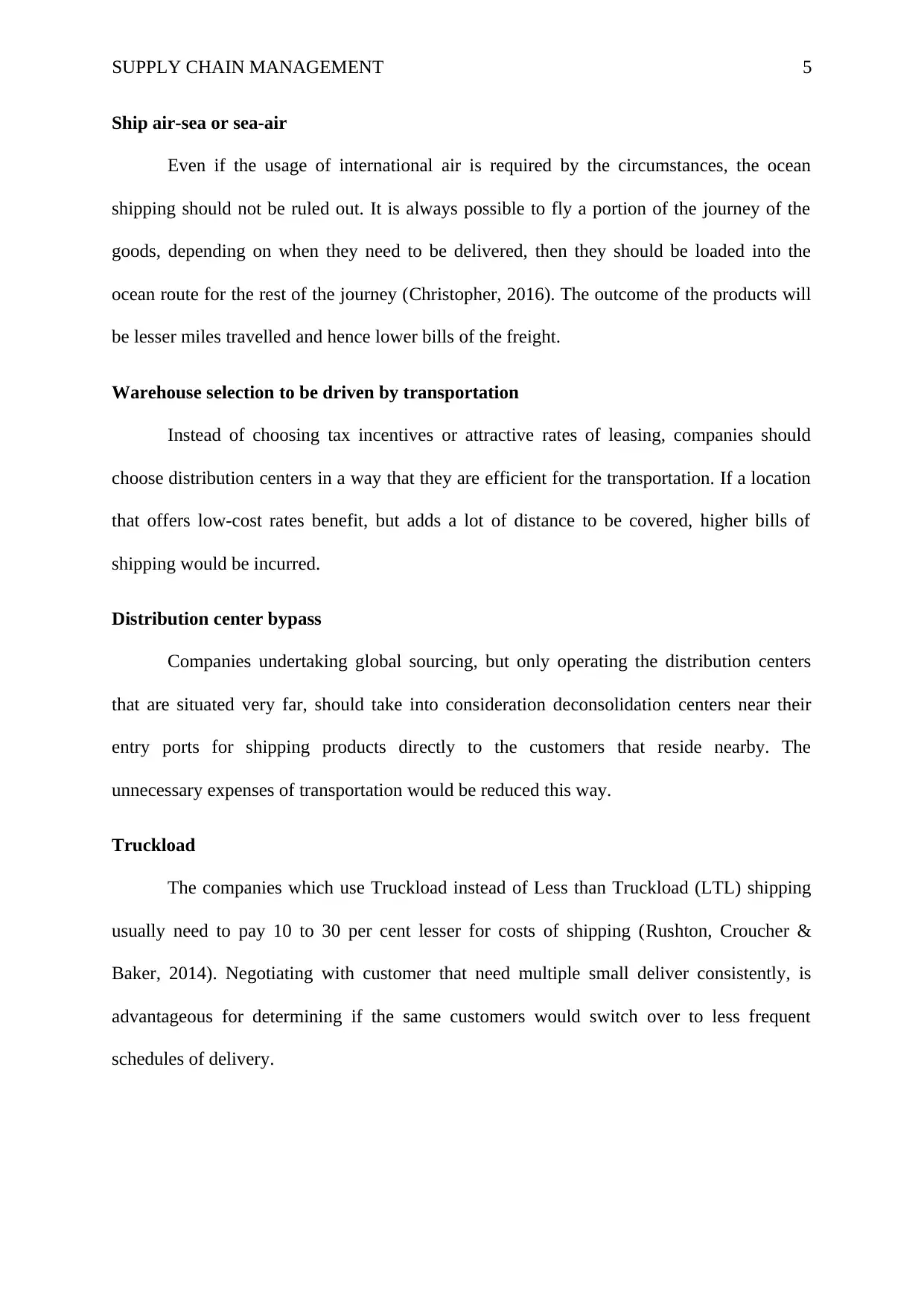
SUPPLY CHAIN MANAGEMENT 5
Ship air-sea or sea-air
Even if the usage of international air is required by the circumstances, the ocean
shipping should not be ruled out. It is always possible to fly a portion of the journey of the
goods, depending on when they need to be delivered, then they should be loaded into the
ocean route for the rest of the journey (Christopher, 2016). The outcome of the products will
be lesser miles travelled and hence lower bills of the freight.
Warehouse selection to be driven by transportation
Instead of choosing tax incentives or attractive rates of leasing, companies should
choose distribution centers in a way that they are efficient for the transportation. If a location
that offers low-cost rates benefit, but adds a lot of distance to be covered, higher bills of
shipping would be incurred.
Distribution center bypass
Companies undertaking global sourcing, but only operating the distribution centers
that are situated very far, should take into consideration deconsolidation centers near their
entry ports for shipping products directly to the customers that reside nearby. The
unnecessary expenses of transportation would be reduced this way.
Truckload
The companies which use Truckload instead of Less than Truckload (LTL) shipping
usually need to pay 10 to 30 per cent lesser for costs of shipping (Rushton, Croucher &
Baker, 2014). Negotiating with customer that need multiple small deliver consistently, is
advantageous for determining if the same customers would switch over to less frequent
schedules of delivery.
Ship air-sea or sea-air
Even if the usage of international air is required by the circumstances, the ocean
shipping should not be ruled out. It is always possible to fly a portion of the journey of the
goods, depending on when they need to be delivered, then they should be loaded into the
ocean route for the rest of the journey (Christopher, 2016). The outcome of the products will
be lesser miles travelled and hence lower bills of the freight.
Warehouse selection to be driven by transportation
Instead of choosing tax incentives or attractive rates of leasing, companies should
choose distribution centers in a way that they are efficient for the transportation. If a location
that offers low-cost rates benefit, but adds a lot of distance to be covered, higher bills of
shipping would be incurred.
Distribution center bypass
Companies undertaking global sourcing, but only operating the distribution centers
that are situated very far, should take into consideration deconsolidation centers near their
entry ports for shipping products directly to the customers that reside nearby. The
unnecessary expenses of transportation would be reduced this way.
Truckload
The companies which use Truckload instead of Less than Truckload (LTL) shipping
usually need to pay 10 to 30 per cent lesser for costs of shipping (Rushton, Croucher &
Baker, 2014). Negotiating with customer that need multiple small deliver consistently, is
advantageous for determining if the same customers would switch over to less frequent
schedules of delivery.
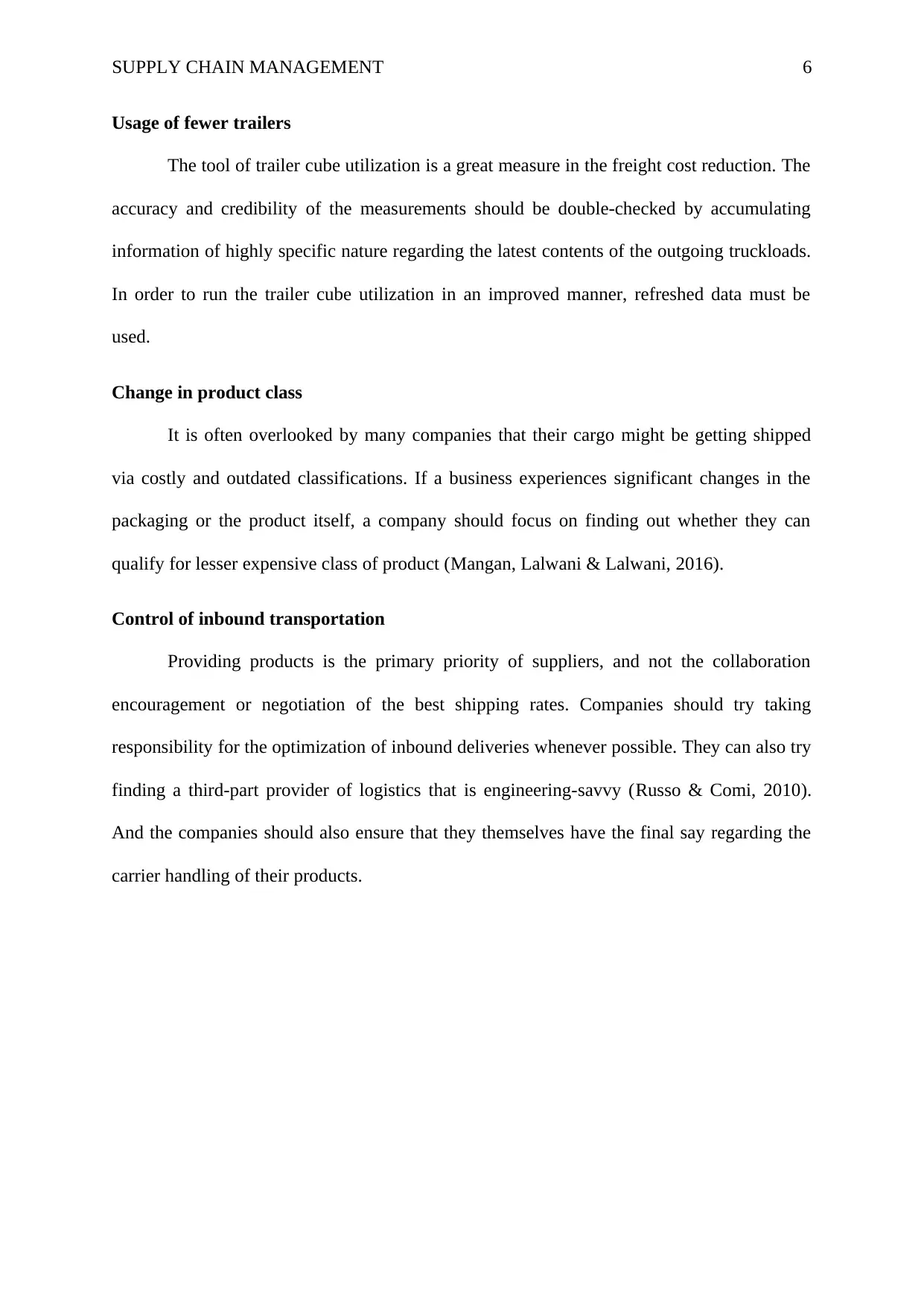
SUPPLY CHAIN MANAGEMENT 6
Usage of fewer trailers
The tool of trailer cube utilization is a great measure in the freight cost reduction. The
accuracy and credibility of the measurements should be double-checked by accumulating
information of highly specific nature regarding the latest contents of the outgoing truckloads.
In order to run the trailer cube utilization in an improved manner, refreshed data must be
used.
Change in product class
It is often overlooked by many companies that their cargo might be getting shipped
via costly and outdated classifications. If a business experiences significant changes in the
packaging or the product itself, a company should focus on finding out whether they can
qualify for lesser expensive class of product (Mangan, Lalwani & Lalwani, 2016).
Control of inbound transportation
Providing products is the primary priority of suppliers, and not the collaboration
encouragement or negotiation of the best shipping rates. Companies should try taking
responsibility for the optimization of inbound deliveries whenever possible. They can also try
finding a third-part provider of logistics that is engineering-savvy (Russo & Comi, 2010).
And the companies should also ensure that they themselves have the final say regarding the
carrier handling of their products.
Usage of fewer trailers
The tool of trailer cube utilization is a great measure in the freight cost reduction. The
accuracy and credibility of the measurements should be double-checked by accumulating
information of highly specific nature regarding the latest contents of the outgoing truckloads.
In order to run the trailer cube utilization in an improved manner, refreshed data must be
used.
Change in product class
It is often overlooked by many companies that their cargo might be getting shipped
via costly and outdated classifications. If a business experiences significant changes in the
packaging or the product itself, a company should focus on finding out whether they can
qualify for lesser expensive class of product (Mangan, Lalwani & Lalwani, 2016).
Control of inbound transportation
Providing products is the primary priority of suppliers, and not the collaboration
encouragement or negotiation of the best shipping rates. Companies should try taking
responsibility for the optimization of inbound deliveries whenever possible. They can also try
finding a third-part provider of logistics that is engineering-savvy (Russo & Comi, 2010).
And the companies should also ensure that they themselves have the final say regarding the
carrier handling of their products.
⊘ This is a preview!⊘
Do you want full access?
Subscribe today to unlock all pages.

Trusted by 1+ million students worldwide
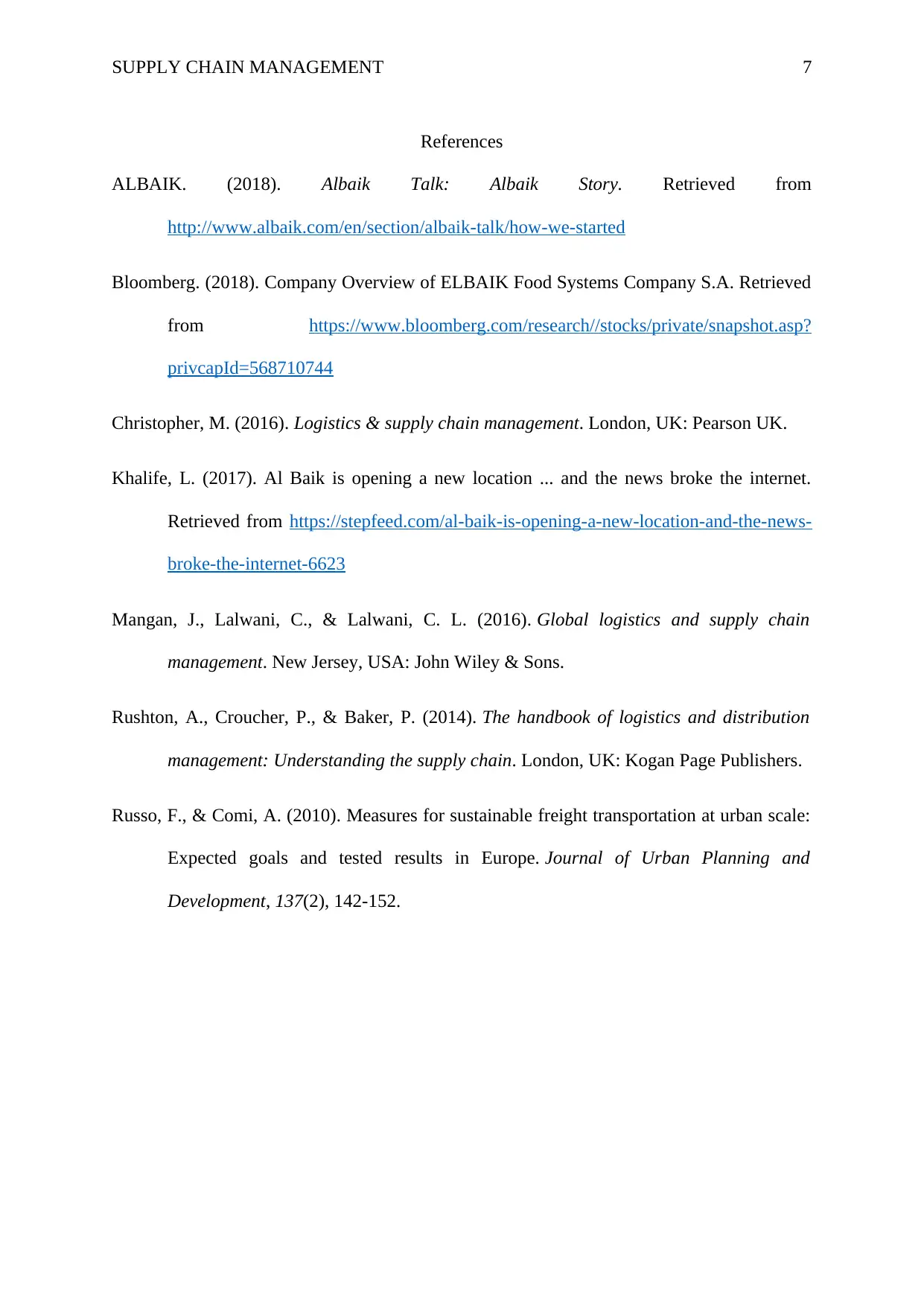
SUPPLY CHAIN MANAGEMENT 7
References
ALBAIK. (2018). Albaik Talk: Albaik Story. Retrieved from
http://www.albaik.com/en/section/albaik-talk/how-we-started
Bloomberg. (2018). Company Overview of ELBAIK Food Systems Company S.A. Retrieved
from https://www.bloomberg.com/research//stocks/private/snapshot.asp?
privcapId=568710744
Christopher, M. (2016). Logistics & supply chain management. London, UK: Pearson UK.
Khalife, L. (2017). Al Baik is opening a new location ... and the news broke the internet.
Retrieved from https://stepfeed.com/al-baik-is-opening-a-new-location-and-the-news-
broke-the-internet-6623
Mangan, J., Lalwani, C., & Lalwani, C. L. (2016). Global logistics and supply chain
management. New Jersey, USA: John Wiley & Sons.
Rushton, A., Croucher, P., & Baker, P. (2014). The handbook of logistics and distribution
management: Understanding the supply chain. London, UK: Kogan Page Publishers.
Russo, F., & Comi, A. (2010). Measures for sustainable freight transportation at urban scale:
Expected goals and tested results in Europe. Journal of Urban Planning and
Development, 137(2), 142-152.
References
ALBAIK. (2018). Albaik Talk: Albaik Story. Retrieved from
http://www.albaik.com/en/section/albaik-talk/how-we-started
Bloomberg. (2018). Company Overview of ELBAIK Food Systems Company S.A. Retrieved
from https://www.bloomberg.com/research//stocks/private/snapshot.asp?
privcapId=568710744
Christopher, M. (2016). Logistics & supply chain management. London, UK: Pearson UK.
Khalife, L. (2017). Al Baik is opening a new location ... and the news broke the internet.
Retrieved from https://stepfeed.com/al-baik-is-opening-a-new-location-and-the-news-
broke-the-internet-6623
Mangan, J., Lalwani, C., & Lalwani, C. L. (2016). Global logistics and supply chain
management. New Jersey, USA: John Wiley & Sons.
Rushton, A., Croucher, P., & Baker, P. (2014). The handbook of logistics and distribution
management: Understanding the supply chain. London, UK: Kogan Page Publishers.
Russo, F., & Comi, A. (2010). Measures for sustainable freight transportation at urban scale:
Expected goals and tested results in Europe. Journal of Urban Planning and
Development, 137(2), 142-152.
1 out of 7
Related Documents
Your All-in-One AI-Powered Toolkit for Academic Success.
+13062052269
info@desklib.com
Available 24*7 on WhatsApp / Email
![[object Object]](/_next/static/media/star-bottom.7253800d.svg)
Unlock your academic potential
Copyright © 2020–2025 A2Z Services. All Rights Reserved. Developed and managed by ZUCOL.





